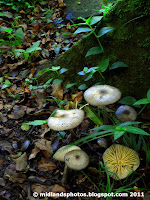Continuing through the undergrowth of the forest leading down into the Howick Falls Gorge, the sound of the falls is hardly noticeable. But, I do now know what a babbling brook is - for the Karkloof stream babbles alongside the path for much of the way. River otters can apparently be seen in the waters if you're lucky enough to spot them. Also present are rock hyrax (dassies), vervet monkeys (not to be fed) and bushbuck. Bird life is not plentiful under the canopy, but from time to time you'll spot a feathered friend darting through the growth, and eagles are known to prey on the smaller mammal inhabitants.
 Do take time to also appreciate the smaller wonders of nature. Some of the most elaborate spider webs I've ever seen were here, and myriad multi-coloured insects scurry beneath the decomposing mulch of fallen leaves and bark. The ferns and fungi are plentiful too and often provide a surprising colour burst against the greens and browns of the foliage (and the mud). Coming from the Falls' viewing platform it is interesting to note how different the vegetation is through this east facing (and therefore shadier) side of the gorge. The sunnier, warmer and drier western facing side tends to have more Paperbark Acacia grassland and aloe vegetation. Sadly a number of alien invader plants threaten the indigenous forests especially the vigorous and rapid seeding balloon vine.
Do take time to also appreciate the smaller wonders of nature. Some of the most elaborate spider webs I've ever seen were here, and myriad multi-coloured insects scurry beneath the decomposing mulch of fallen leaves and bark. The ferns and fungi are plentiful too and often provide a surprising colour burst against the greens and browns of the foliage (and the mud). Coming from the Falls' viewing platform it is interesting to note how different the vegetation is through this east facing (and therefore shadier) side of the gorge. The sunnier, warmer and drier western facing side tends to have more Paperbark Acacia grassland and aloe vegetation. Sadly a number of alien invader plants threaten the indigenous forests especially the vigorous and rapid seeding balloon vine.
Again (as in yesterday's posting) the lighting on this walk can be challenging, and I found my best shots were taken where either the light filters in rays through the trees, or where the shade was solid allowing a consistent light reading.
Again (as in yesterday's posting) the lighting on this walk can be challenging, and I found my best shots were taken where either the light filters in rays through the trees, or where the shade was solid allowing a consistent light reading.
No comments:
Post a Comment